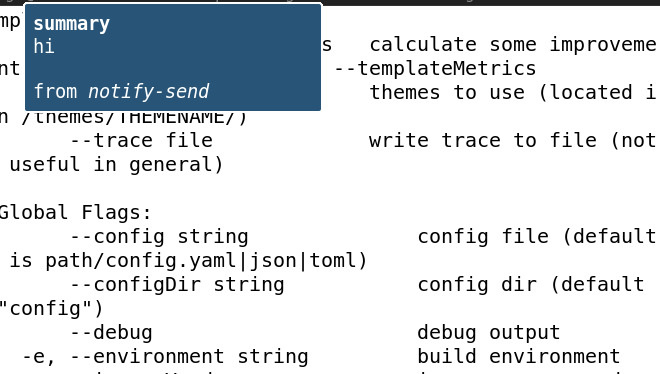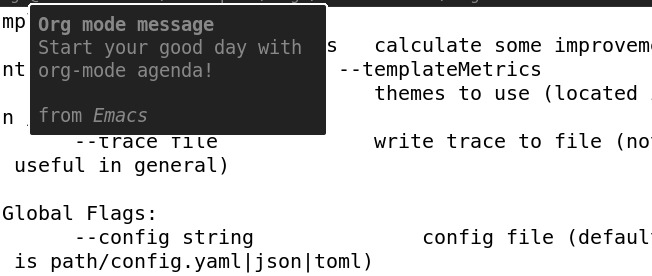I barely use notifications, but recently I think it's a valuable way to remind me things like helping me nurture habits, or to notify me of emergencies like a critically low laptop battery.
So I try to integrate notifications to org-mode and Emacs today.
The org-notify package from org-contrib (install it by (package-install 'org-contrib) ) could do this job easily before, so I first test it in the minibuffer with (org-notify "test").
Unfortunately, it errors out:
Debugger entered--Lisp error: (dbus-error "Could not activate remote peer.")
signal(dbus-error ("Could not activate remote peer."))
dbus-call-method(:session "org.freedesktop.Notifications" "/org/freedesktop/Notifications" "org.freedesktop.Notifications" "Notify" :string "Emacs" :uint32 0 :string "/usr/share/emacs/27.2/etc/images/icons/hicolor/sca..." :string "Org mode message" :string "test" (:array) ((:dict-entry "urgency" (:variant :byte 0))) :int32 3000)
notifications-notify(:title "Org mode message" :body "test" :timeout 3000 :urgency low)
org-show-notification("test")
org-notify("test")
eval((org-notify "test") t)
eval-expression((org-notify "test") nil nil 127)
funcall-interactively(eval-expression (org-notify "test") nil nil 127)
call-interactively(eval-expression nil nil)
command-execute(eval-expression)Before switching to i3wm, I did receive notifications on GNOME, but I never saw one on i3wm. After searching for i3wm and notification, I realized that it's because there is no notification daemon running, and Dunst pops into my eyes.
Dunst is a lightweight replacement for the notification daemons provided by most desktop environments. The selling points are:
- Customizability
- Rules
- Multi-monitor Support
- History
- Keyboard-Driven
- Context Menu
- Scriptable
That sounds a perfect fit for me. Let's get started with it.
Install dunst from the repository and start it up with systemctl start --user dunst and test it with notify-send summary hi, it works!

But I don't like the default styling and the popup window position (at the top-right corner), and let's tweak it.
Copy the default file (cp /usr/share/dunst/dunstrc ~/.config/dunst/dunstrc) and start from the default settings. Since the file is well commented, I barely look up the online docs, the things that I customize are:
@@ -1,3 +1,4 @@
[global]
### Display ###
@@ -29,7 +30,7 @@
# the top and down respectively.
# The width can be negative. In this case the actual width is the
# screen width minus the width defined in within the geometry option.
- geometry = "300x5-30+20"
+ geometry = "300x5+30+20"
# Show how many messages are currently hidden (because of geometry).
indicate_hidden = yes
@@ -61,10 +62,10 @@
# Defines width in pixels of frame around the notification window.
# Set to 0 to disable.
- frame_width = 3
+ frame_width = 2
# Defines color of the frame around the notification window.
- frame_color = "#aaaaaa"
+ frame_color = "#fefefe"
# Define a color for the separator.
# possible values are:
@@ -86,7 +87,7 @@
### Text ###
- font = Monospace 8
+ font = Monospace 14
# The spacing between lines. If the height is smaller than the
# font height, it will get raised to the font height.
@@ -126,7 +127,7 @@
# %n progress value if set without any extra characters
# %% Literal %
# Markup is allowed
- format = "<b>%s</b>\n%b"
+ format = "<b>%s</b>\n%b\n\nfrom <i>%a</i>"
# Alignment of message text.
# Possible values are "left", "center" and "right".
@@ -183,7 +184,7 @@
dmenu = /usr/bin/dmenu -p dunst:
# Browser for opening urls in context menu.
- browser = /usr/bin/firefox -new-tab
+ browser = xdg-open
# Always run rule-defined scripts, even if the notification is suppressed
always_run_script = true
@@ -213,7 +214,7 @@
# corners.
# The radius will be automatically lowered if it exceeds half of the
# notification height to avoid clipping text and/or icons.
- corner_radius = 0
+ corner_radius = 2
### Legacy
@@ -258,19 +259,19 @@
# Xev might be helpful to find names for keys.
# Close notification.
- close = ctrl+space
+ # close = ctrl+space
# Close all notifications.
- close_all = ctrl+shift+space
+ # close_all = ctrl+shift+space
# Redisplay last message(s).
# On the US keyboard layout "grave" is normally above TAB and left
# of "1". Make sure this key actually exists on your keyboard layout,
# e.g. check output of 'xmodmap -pke'
- history = ctrl+grave
+ # history = ctrl+grave
# Context menu.
- context = ctrl+shift+period
+ # context = ctrl+shift+period
[urgency_low]
# IMPORTANT: colors have to be defined in quotation marks.
You can check out my final config at https://github.com/whatacold/extensible-dotfiles/blob/master/home/.config/dunst/dunstrc.
Then test it with (org-notify "Emacs org-mode test"), it works as expected:

The last thing is to remind me things when Emacs starts up:
(run-with-timer 60 nil
(lambda ()
(org-notify "Start your good day with org-mode agenda!")))To recap, Dunst is well documented. It doesn't cost me much time to get it up. And if you use a tiling window manager like i3wm, you should give it a try.